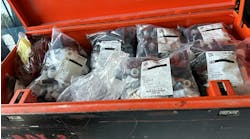Latest from Plumbing
Sponsored
There are two primary concerns related to the proper operation of toilet fixtures — flushing performance and drain line carry. While it is fairly easy to define an adequate level of flushing performance (we want the toilet to remove all of the waste from the bowl in a single flush), it is far more difficult to define how far a toilet flush should transport this waste through the building drain piping to the sewer. There are many things to consider when attempting to assess drain line carry performance, e.g., how much waste is being flushed, what type of waste is being flushed, what is the diameter and slope of the drain line, what is the age and physical condition of the drain, etc.
The current ASME/CSA drain line carry testing protocol not only uses non-realistic test media (¾-in. plastic balls), it also uses the same testing procedure regardless of whether toilet fixtures are residential or commercial models. Therefore, we believe this protocol fails to adequately address the concern of real waste movement in the drain system. This is somewhat disconcerting since we know A) that there is a clear difference between ¾-in. balls and “real” waste and B) that there are significant differences between residential and commercial toilet installations. For example:
-
Commercial fixtures are often installed on 4-in. diameter drainpipes set at a 1% slope whereas residential fixtures are typically installed on 3-in. diameter pipes set at a 2% slope.
-
Commercial toilets, which are often required to flush paper toilet seat covers, paper towels, large amounts of toilet paper, etc., are typically subjected to a much greater waste loading than residential toilets.
-
The lengths of drain runs are often much longer in commercial installations.
-
Supplemental flows are often much less in commercial installations (supplemental flows from bathing, clothes washing, etc., help transport waste through drain lines).
A significant number of testing programs have shown a direct correlation between drain line carry distance and flush volume. As such, we know that if we continue to reduce toilet flush volumes without making commensurate changes to the plumbing and drain system, we will eventually begin to experience blockages in drains. This is a fact!
While we are relatively confident that high-efficiency toilets (HETs) are suitable for use in residential applications because of the smaller diameter drain piping, steeper slope, and availability of supplemental flows, we are not nearly as sure about the use of HETs in all commercial applications. We know by experience that 1.6-gal. (6L) of water appear to be sufficient to satisfactorily transport waste in commercial sites, and we know by experimental data that there is some flush volume less than 1.6-gal. where we will begin to experience problems. The problem is that we don't know what that lower volume is. What's more, we want to avoid a situation where the flush volumes of commercial toilets are reduced to the point where drain line problems begin to occur with frequency only to have to “take a step back” and increase the flush volume back to 1.6-gal.
There are significant differences between residential and commercial toilets — both in their physical construction and operation. There is no inherent reason that they should be required to pass the same flush performance and drain line testing requirements or that they should necessarily flush at the same volume.
While we are not saying that installing HETs in commercial installations will necessarily lead to drain line plugging and problems, we are suggesting that caution be used when choosing whether or not to install HETs in existing commercial sites — especially if the physical conditions of the existing drain lines may be suspect or if there are little or no supplemental flows available at the site to augment the carry of waste. In new construction, we recommend that building designers seriously consider A) the placement of water consuming fixtures (e.g., lavatories and flushing urinals) upstream of the HETs and B) providing for drain line slopes of greater than 1%.
Bill Gauley, P. Eng., Veritec Consulting, Mississauga, Ontario, Canada, and John Koeller, P.E., Koeller & Co., Yorba Linda, Calif., created the MaP Test laboratory protocol for testing the efficacy of low-flush and high-efficiency water closets. They can be reach at [email protected] and [email protected].

